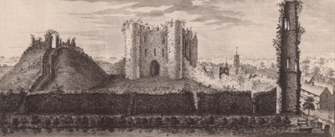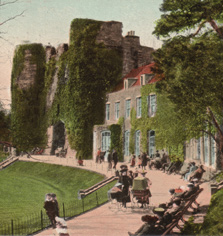

Tonbridge’s first castle was a simple fort of earth and timber, thrown up – like hundreds of others – by Norman invaders for self-protection soon after they arrived in 1066. It stood on land overlooking the Medway crossing which William the Conqueror had given to his kinsman Richard Fitzgilbert. Local labour would have been used to shift the 30,000 tonnes of earth required to form the moat and the motte – the ’castle mound’ which still survives. A wooden keep would have been built on top of the motte, with an adjacent area, the bailey (now the Castle Lawn) protected by a fence of stakes.
An aerial view of the Castle as it is today. Move the cursor on to the picture to see how it may have looked in the 13th century (reconstruction based on available historical evidence).
The wooden castle probably only survived about twenty years. Descendants of Richard Fitzgilbert gradually replaced the earth and timber structure with stone, repairing the effects of decay, fire and warfare and reinforcing their stronghold against improved methods of attack. Their final castle had a noble gatehouse and was encircled by massive curtain walls connecting great towers at each corner, while a high shell keep crowned the motte. In places the castle walls were almost three metres thick, with sandstone facings from nearby quarries. Kings fought and were entertained at Tonbridge Castle, archbishops quarrelled over its guardianship, and Henry III’s niece and Edward I’s daughter were both mistresses of the castle. In Henry VIII’s reign the gatehouse was deemed to be "as strong a fortress as few be in England".

The castle in 1735 showing motte and gatehouse, and with more of the curtain walls and south-east tower than now survive. (THS6.004a)
In the Civil War the Castle was strengthened and garrisoned. Thomas Weller, who owned it at that time, was a Parliamentarian. He joined other West Kent gentlemen in opposing local unrest at Sevenoaks in 1643, and there was a three-hour skirmish on the outskirts of Tonbridge at Hilden Brook. The river crossing was fought over but not, it seems, the castle itself – though the Roundhead garrison wreaked havoc in the grounds. Later Weller was ordered to put the castle beyond military use by dismantling its defences.

In the 20th century the Castle became a place of recreation for Tonbridge people.
A later owner, John Hooker, sold stone from the castle to build locks on the River Medway, and in 1791 his son Thomas took more stone from the ruined walls to build the residence that now adjoins the Gatehouse. What was left of the once-proud fortress became in turn a private home, a military academy and a prep school until in 1899 it was purchased by the Town Council. The residence became the Council Chamber and offices, and the grounds were opened to the public.
Nearly 900 years from its first construction, Tonbridge Castle saw military service once more, as part of a defensive line against possible German invasion in World War 2. Anti-tank defences and a machine-gun emplacement were constructed, and two pillboxes built into the 13th century walls.
>More Castle pictures here.
Articles by Sydney Simmons entitled ‘Tonbridge Castle: Further Observations on an ancient Castle’ and ‘The Lords and Ladies of Tonbridge Castle’ were published in Archaeologia Cantiana Vol. 116, pp101-146 (1996) and Vol. 118, pp45-62 (1998) respectively. Archaeologia Cantiana is available in Tonbridge Reference Library.